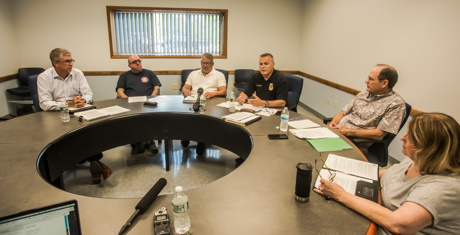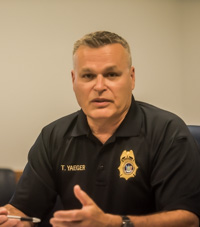
There is a crisis brewing in fire and EMS coverage in Genesee County, but it's invisible to most area residents, according to a report released this week by the Office of Emergency Management.
The report was prepared by Municipal Resources, a consulting firm hired to review the state of fire and EMS services locally and recommend changes.
"The challenges that are facing the fire and EMS services in Genesee County are very real; there is a crisis that is slowly building, and has been for a considerable period," the report states. "The reason that many stakeholders, municipal leaders, and the general public do not see 'evidence' is the long tradition in both the fire and EMS services of 'getting the job done.'
"Looking ahead," according to the report, "the implications of not taking action will be quite simple: service levels will continue to diminish, some companies and EMS agencies may fold under financial pressures or because they are just not viable responders any longer, and fewer and fewer most likely aging volunteer members will be trying to respond to an increasing number of requests for service."
The 278-page report contains 95 recommendations to improve services and ensure the long-term viability of fire and EMS services in the county.
The report was presented to local media for the first time on Wednesday night at the Fire Training Center on Bank Street Road in Batavia by members of a task force formed two years ago. The members, which included volunteer firefighters, elected officials, and Tim Yaeger, emergency management coordinator, set a goal of finding actionable recommendations on how to improve things and not just produce another study.

The purpose of the report as some have assumed, said task force chairman Eric Weis (president of the Bergen Fire Department), is to push through a replacement of the current volunteer fire department system with a paid, countywide fire department.
He noted the report contains this statement: "It should be clearly understood by all stakeholders that the focus of this report is to augment and not supplant existing fire and EMS resources. Therefore, recommendations are focused on better utilization of existing organizations and resources while maintaining, supporting, and strengthening existing organizations."
Weis put the same sentiment in his own words.
"The volunteers are the backbone of the emergency services in the county," Weis said. "This is not intended to, again, take away from that. It's intended to enhance it. And I also want to say that, yes, there are issues, but, you know, the members of the volunteer departments in this county put forth a hell of a lot of effort every day. I think the needs are being met."
The biggest challenge for fire departments and EMS companies in Genesee County is the nationwide decline in volunteerism. Genesee County is not unique. People are much less likely to volunteer for anything, let alone service as demanding as firefighting or emergency medical assistance.
The report states:
The only reason why the challenges the system is facing both today and looking to the future are not more evident is because of the passion and dedication of the members of the county’s fire and EMS organizations who continue to answer the calls for service. But the number of active volunteers is declining in the county as they are everywhere, and many of those who remain are aging.
The crisis of volunteerism
The report anonymously quotes a volunteer chief, "Volunteerism is being killed by social changes and increasing training standards for liability reasons. With fire call volumes being low and EMS requests high, we are at the point of high-risk low frequency events being a large concern. People don’t want to put in the time to train to fight one or two fires annually."
Long gone are the days when a young person could volunteer for the local fire department, be handed a helmet and coat, and start showing up at fire scenes. Now volunteer firefighters must go through hours and hours of training just to get started, and dozens of hours more every year to advance their skills.
And "volunteer" means they don't get paid for any of that time, either training or responding to incidents.
"I think most people in the community have no idea the amount of hours that they (volunteers) commit to this job," said Yaeger (first inset photo). "They are many hours away from home, away from family, away from work, to get this job done.
"I think many citizens probably assume that volunteers are compensated to some extent," Yaeger said later. "And other than food and refreshments at a training or after an event, there is no compensation."
Among the 95 recommendations offered by Municipal Resources is finding some way to make some sort of compensation possible, be it monetary, health insurance, or gift cards to local businesses. But that isn't possible currently because state law prohibits any compensation to volunteer firefighters.
County Legislator Gordon Dibble, who served on the task force, said he and his fellow elected officials are ready to try and tackle that problem, which means going to the state Legislature to change the law statewide or working with Assemblyman Steve Hawley on a change in the law allowing Genesee County to become the first county to compensate volunteer firefighters and EMS personnel.
"I don't think we've (the Legislature) talked about that," Dibble said. "We haven't come to that, but I could agree with you that might be a way to go. It might help our situation. It starts somewhere and sometimes it starts with a small tiny county government that moves it up through the state."
Compensation needs to be an option
New York needs to catch up with other parts of the country, Yaeger said, when it comes to compensating volunteer firefighters. In other parts of the country, volunteers aren't paid wages as much as they are provided pay on a per diem basis.
"They're being paid a stipend," Yaeger said. "They're being paid to be on-call. They're being paid to go to training. They're not making what a career firefighter is making, because they're just being paid or compensated when they're performing a duty for the community. That's something else that we need to pursue. And that needs to happen sooner than later because it's just inevitable."
One option to make volunteer firefighting less of time management challenge is to give volunteers on-call schedules so they know when its their turn to respond to any calls that come in and are prepared to respond.

The EMS crisis
The report also highlights the challenges facing ambulance providers, whether the all-volunteer services provided by departments such as Byron, Bergen, Alexander, and Bethany, or the paid-personnel services, what Yaeger refers to as "commercial," such as Le Roy Ambulance and Mercy EMS.
Currently, the mixture of volunteer and commercial EMS services are keeping response times in most of the county under four minutes for basic life support calls and eight minutes for advanced life support.
These are critical numbers when the calls are for cardiac arrest (less than two percent of EMS calls) or stroke.
The report states:
Heart attack and stroke victims require rapid intervention and care, and transport to a medical facility. The longer the time duration without care, the less likely the patient is to fully recover. Numerous studies have shown that irreversible brain damage can occur if the brain is deprived of oxygen for more than four minutes. In addition, the potential for successful resuscitation during cardiac arrest decreases exponentially, 7 to 10%, with each passing minute that cardio-pulmonary resuscitation (CPR) or cardiac defibrillation and ALS intervention is delayed. Few attempts at resuscitation after 10 minutes are successful.
Keeping EMS services staffed is both a challenge for volunteer departments and Mercy EMS and Le Roy Ambulance. The training hours to qualify as a crew member can be up to 150 hours and the duty is hard and often puts EMTs in harm's way.
Mercy EMS recently went through a staffing crisis that required assistance from services from outside the county and the turnover in personnel is frequent, with employees either finding the work isn't for them or using their training and experience as a stepping stone into a career as a paid firefighter.
"The environments that they're working in are not the best environments," Yaeger said. "People don't need to know what some of those environments are but it's a dangerous job. They're exposed to a lot of things that they probably shouldn't be exposed to."
In New York, as in most of the country, ambulances are not considered an essential service, like police and fire services. Municipalities are not required to provide EMS coverage. The report suggests that needs to change.
Among the consultants' recommendations, as one option, is the creation of a countywide EMS service.
This model would have the county assume all EMS response and transport responsibilities for EMS. The county would have to hire full-time personnel and purchase all equipment and vehicles to staff four units. These units would need to be housed in strategic locations across the county to meet response time benchmarks county wide. While this concept is relatively new in New York state, several counties have either implemented this type of service or, are exploring the concept.
Countywide cooperation
While the report doesn't call for a countywide fire service, there are recommendations for standardizing operations. That means establishing compatible Standard Operating Procedures across all departments so that when departments are working together, they're all using the same tactics and methods.
"Everyone in the fire service knows that we're already responding regionally," Yaeger said. "So how do we formalize that to make sure that everybody is on the same sheet of music? How do we make sure that the funding sources are there and available for all those resources to come in so we're not duplicating resources, we're not duplicating equipment?"
Getting everyone on the same sheet of music could eventually lead to a countywide department, but that won't happen any time soon, Yaeger said.
"Thirty years from now, 20 years from now, could there be a county-wide fire service? I won't be here to see it. Not in this position. But sure, it could happen," Yaeger said. "It takes time to see if it's even necessary. It may not be necessary. We may find that there are ways to work together and make our system better without forming a countywide service."
Going forward
With 95 recommendations, there is a lot for all the stakeholders to consider what priorities should be tackled first. That process will involve everyone at all of the departments as volunteers read the report and come back with recommendations.
Task force members say that so far, the report has been received favorably, but they know that there will be those who resist change of any kind.
"(Somebody) coined the phrase that 'firefighters say the two things they hate the most are the way things are, and change,'" Yaeger said.
Weis said he hopes to see each department provide the task force with five, 10, or maybe 15 priorities from the 95 recommendations. The task force will use that feedback to come up with 10 to 15 action items to tackle first.
"We really want feedback first from the departments," Weis said. "Before we kind of settle on the 10, or maybe 15, before we settle on those, we want the feedback from departments. We don't feel we want to just dictate the solution."
PDF Downloads:
Top photo: Six members of the task force, from left, Eric Weis, president, Bergen Fire, Mike Heale, chief, Elba, Bob Mruzak, fire chief, Bergen, Tim Yaeger, Genesee County Emergency Management Coordinator, Gordon Dibble, Genesee County legislator, Donna Hynes, supervisor, Town of Elba. Not present and not pictured, Legislator Greg Torrey and Pavilion Supervisor Robert LaPoint.
Photos by Howard Owens
